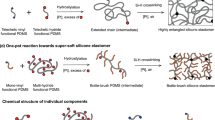Abstract
Soft conducting elastomers have been prepared from polydimethylsiloxane-polyethyleneglycol (PDMS-PEG) copolymer and surfactant-stabilized multi-walled carbon nanotubes (MWCNTs). The copolymer was chain-extended with PDMS of molecular weight 17.2 kg mol-1 in order to obtain a crosslinkable PDMS with molecular weight around 20 – 30 kg mol-1. MWCNTs were treated with surfactant and sonicated for better dispersion in the polymer matrix. The conductivity and mechanical properties of conducting elastomers were thoroughly investigated including stress and strain at break. The developed conducting elastomers showed high conductivity combined with inherent softness. The high conductivity and softness, PDMS-PEG copolymers with incorporated MWCNTs hold great promises as compliant and highly stretchable electrodes for stretchable devices such as electro-mechanical transducers.
Similar content being viewed by others
References
D. Kim, N. Lu, R. Ma, Y.-S. Kim, R.-H. Kim, S. Wang, J. Wu, S. M. Won, H. Tao, A. Islam, K. J. Yu, T. Kim, R. Chowdhury, M. Ying, L. Xu, M. Li, H.-J. Chung, H. Keum, M. McCormick, P. Liu, Y. Zhang, F. G. Omenetto, Y. Huang, T. Coleman, and J. A. Rogers, “Epidermal electronics,”Science, vol. 333, pp. 838–843, 2011.
S. Rosset and H. R. Shea, “Flexible and stretchable electrodes for dielectric elastomer actuators,”Appl. Phys. A Mater. Sci. Process., vol. 110, pp. 281–307, 2013.
D. J. Lipomi and Z. Bao, “Stretchable, elastic materials and devices for solar energy conversion,”Energy Environ. Sci., vol. 4, no. 9, pp. 3314–3328, 2011.
A. H. A Razak, P. Szabo, and A. L. Skov, “Enhancement of dielectric permittivity by incorporating PDMS-PEG multiblock copolymers in silicone elastomers,”RSC Adv., vol. 5, pp. 53054–53062, 2015.
A. Thess, R. Lee, P. Nikolaev, H. Dai, P. Petit, C. Xu, Y. H. Lee, S. G. Kim, A. G. Rinzler, D. T. Colbert, G. E. Scuseria, D. Tománek, J. E. Fischer, R. E. Smalley, J. Robert, and D. Tomanek, “All use subject to JSTOR Terms and Conditions Crystalline Ropes of Metallic Carbon Nanotubes,”Science, vol. 273, pp. 483–487, 2014.
P. C. Ma, S. Q. Wang, J.-K. Kim, and B. Z. Tang, “In-Situ amino functionalization of carbon nanotubes using ball milling,”J. Nanosci. Nanotechnol., vol. 9, pp. 749–753, 2009.
Y. Geng, M. Y. Liu, J. Li, X. M. Shi, and J. K. Kim, “Effects of surfactant treatment on mechanical and electrical properties of CNT/epoxy nanocomposites,”Compos. Part A Appl. Sci. Manuf., vol. 39, no. 12, pp. 1876–1883, 2008.
K. C. Park, T. Hayashi, H. Tomiyasu, M. Endo, and M. S. Dresselhaus, “Progressive and invasive functionalization of carbon nanotube sidewalls by diluted nitric acid under supercritical conditions,”J. Mater. Chem., vol. 15, no. 3, pp. 407–411, 2005.
Y. J. Kim, T. S. Shin, H. Do Choi, J. H. Kwon, Y.-C. Chung, and H. G. Yoon, “Electrical conductivity of chemically modified multiwalled carbon nanotube/epoxy composites,”Carbon N. Y., vol. 43, pp. 23–30, 2005.
R. Rastogi, R. Kaushal, S. K. Tripathi, A. L. Sharma, I. Kaur, and L. M. Bharadwaj, “Comparative study of carbon nanotube dispersion using surfactants,”J. Colloid Interface Sci., vol. 328, no. 2, pp. 421–428, 2008.
A. E. Vladár, “Strategies for scanning electron microscopy sample preparation and characterization of multiwall carbon nanotube polymer composites,”NIST Spec. Publ. 1200-17, vol. 1, pp. 1–16, 2015.
L. Yu, F. B. Madsen, S. Hvilsted, and A. L. Skov, “High energy density interpenetrating networks from ionic networks and silicone,”Proc. SPIE, vol. 9430, pp. 94300T–1–94300T–11, 2015.
D. Y. Wu, S. Meure, and D. Solomon, “Self-healing polymeric materials: A review of recent developments,”Prog. Polym. Sci., vol. 33, no. 5, pp. 479–522, 2008.
Author information
Authors and Affiliations
Rights and permissions
About this article
Cite this article
Razak, A.H.A., Madsen, F.B. & Skov, A.L. Mechanically Compliant Electrodes and Dielectric Elastomers from PEG-PDMS Copolymers. MRS Advances 1, 3497–3508 (2016). https://doi.org/10.1557/adv.2016.404
Published:
Issue Date:
DOI: https://doi.org/10.1557/adv.2016.404




